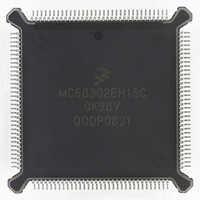MC68302EH16C Freescale Semiconductor, MC68302EH16C Datasheet - Page 219

MC68302EH16C
Manufacturer Part Number
MC68302EH16C
Description
IC MPU MULTI-PROTOCOL 132-PQFP
Manufacturer
Freescale Semiconductor
Datasheets
1.MC68302AG20C.pdf
(4 pages)
2.MC68302AG20C.pdf
(2 pages)
3.MC68302AG20C.pdf
(13 pages)
4.MC68302EH16C.pdf
(481 pages)
Specifications of MC68302EH16C
Processor Type
M683xx 32-Bit
Speed
16MHz
Voltage
5V
Mounting Type
Surface Mount
Package / Case
132-MQFP, 132-PQFP
Controller Family/series
68K
Core Size
32 Bit
Ram Memory Size
1152Byte
Cpu Speed
16MHz
No. Of Timers
3
Embedded Interface Type
SCP, TDM
Digital Ic Case Style
PQFP
Rohs Compliant
Yes
Family Name
M68000
Device Core
ColdFire
Device Core Size
32b
Frequency (max)
16MHz
Instruction Set Architecture
RISC
Supply Voltage 1 (typ)
5V
Operating Temp Range
0C to 70C
Operating Temperature Classification
Commercial
Mounting
Surface Mount
Pin Count
132
Package Type
PQFP
Lead Free Status / RoHS Status
Lead free / RoHS Compliant
Features
-
Lead Free Status / Rohs Status
RoHS Compliant part
Electrostatic Device
Available stocks
Company
Part Number
Manufacturer
Quantity
Price
Company:
Part Number:
MC68302EH16C
Manufacturer:
Freescale Semiconductor
Quantity:
135
Company:
Part Number:
MC68302EH16C
Manufacturer:
PANA
Quantity:
99
Company:
Part Number:
MC68302EH16C
Manufacturer:
Freescale Semiconductor
Quantity:
10 000
Part Number:
MC68302EH16C
Manufacturer:
FREESCALE
Quantity:
20 000
Company:
Part Number:
MC68302EH16CB1
Manufacturer:
Freescale Semiconductor
Quantity:
10 000
Company:
Part Number:
MC68302EH16CR2
Manufacturer:
Freescale Semiconductor
Quantity:
10 000
- MC68302AG20C PDF datasheet
- MC68302AG20C PDF datasheet #2
- MC68302AG20C PDF datasheet #3
- MC68302EH16C PDF datasheet #4
- Current page: 219 of 481
- Download datasheet (2Mb)
4.5.13.14 Programming the BISYNC Controllers
There are two general techniques that the software may employ to handle data received by
the BISYNC controllers. The simplest way is to allocate single-byte receive buffers, request
(in the status word in each BD) an interrupt on reception of each buffer (i.e., byte), and im-
plement the BISYNC protocol entirely in software on a byte-by-byte basis. This simple ap-
proach is flexible and may be adapted to any BISYNC implementation. The obvious penalty
is the overhead caused by interrupts on each received character.
A more efficient method is as follows. Multibyte buffers are prepared and linked to the re-
ceive buffer table. Software is used to analyze the first (two to three) bytes of the buffer to
determine what type of block is being received. When this has been determined, reception
can continue without further intervention to the user's software until a control character is
encountered. The control character signifies the end of the block, causing the software to
revert back to a byte-by-byte reception mode.
To accomplish this, the RCH bit in the BISYNC mask register should initially be set, enabling
an interrupt on every byte of data received. This allows the software to analyze the type of
block being received on a byte-by-byte basis. After analyzing the initial characters of a block,
the user should either set the receiver transparent mode (RTR) bit in the BISYNC mode reg-
ister or issue the RESET BCS CALCULATION command. For example, if DLE-STX is re-
ceived, transparent mode should be entered. By setting the appropriate bit in the BISYNC
mode register, the BISYNC controller automatically strips the leading DLE from <DLE-char-
acter> sequences. Thus, control characters are only recognized when they follow a DLE
character. The RTR bit should be cleared after a DLE-ETX is received.
Alternatively, after receiving an SOH, the RESET BCS CALCULATION command should be
issued. This command causes the SOH to be excluded from BCS accumulation and the
BCS to be reset. Note that the RBCS bit in the BISYNC mode register (used to exclude a
character from the BCS calculation) is not needed here since SYNCs and leading DLEs (in
transparent mode) are automatically excluded by the BISYNC controller.
After recognizing the type of block above, the RCH interrupt should be masked. Data recep-
tion then continues without further interruption of the M68000 core until the end of the cur-
rent block is reached. This is defined by the reception of a control character matching that
programmed in the receive control characters table.
The control characters table should be set to recognize the end of the block as follows:
After the end of text (ETX), a BCS is expected; then the buffer should be closed. Hunt mode
should be entered when line turnaround occurs. ENQ characters are used to abort transmis-
MOTOROLA
Control Characters
Next Entry
ENQ
MC68302 USER’S MANUAL
ETX
ETB
ITB
E
0
0
0
0
1
B
X
1
1
1
0
Communications Processor (CP)
H
X
1
0
1
0
4-99
Related parts for MC68302EH16C
Image
Part Number
Description
Manufacturer
Datasheet
Request
R
Part Number:
Description:
Manufacturer:
Freescale Semiconductor, Inc
Datasheet:

Part Number:
Description:
MC68302 Configuring the Chip Selects on the MC68302
Manufacturer:
Motorola / Freescale Semiconductor

Part Number:
Description:
MC68302 Design Concept - Expanding Interrupts on the MC68302
Manufacturer:
Motorola / Freescale Semiconductor

Part Number:
Description:
MC68302 MC68302 Adapting a WAN Controller to a LAN Environment
Manufacturer:
Motorola / Freescale Semiconductor

Part Number:
Description:
MC68302 EKB Applications - Power Measurements on the MC68302
Manufacturer:
Motorola / Freescale Semiconductor

Part Number:
Description:
MC68302 Interfacing the MC68020 to a Slave MC68302
Manufacturer:
Motorola / Freescale Semiconductor

Part Number:
Description:
MC68302 MC68302 Software Performance
Manufacturer:
Motorola / Freescale Semiconductor

Part Number:
Description:
MC68302 Evaluating EDX on the ADS302
Manufacturer:
Motorola / Freescale Semiconductor

Part Number:
Description:
MC68302 Design Advisory #1 - MC68SC302 Passive ISDN Protocol Engine
Manufacturer:
Motorola / Freescale Semiconductor

Part Number:
Description:
MC68302, MC68360, and MPC860 Characteristics and Design Notes for Crystal Feedback Oscillators
Manufacturer:
Motorola / Freescale Semiconductor
Part Number:
Description:
Mc68302 Integrated Multi-protocol Processor
Manufacturer:
Freescale Semiconductor, Inc
Datasheet:
Part Number:
Description:
Manufacturer:
Freescale Semiconductor, Inc
Datasheet:
Part Number:
Description:
Manufacturer:
Freescale Semiconductor, Inc
Datasheet:
Part Number:
Description:
Manufacturer:
Freescale Semiconductor, Inc
Datasheet:
Part Number:
Description:
Manufacturer:
Freescale Semiconductor, Inc
Datasheet:











